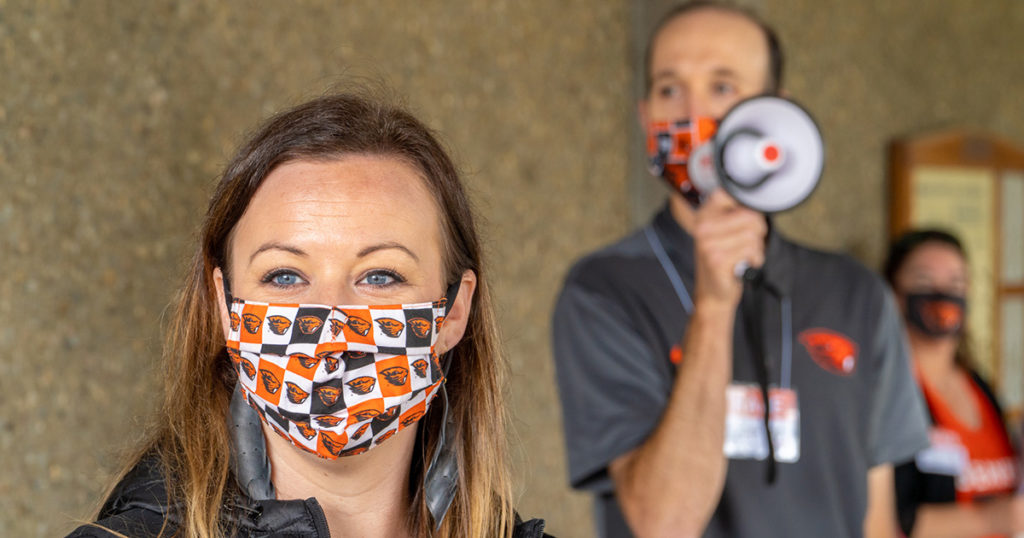
By Sean Nealon
Preliminary results of a second round of door-to-door sampling by Oregon State University in Newport suggest a significantly lower prevalence of the novel coronavirus that causes COVID-19 on July 11-12 than compared to a similar sampling three weeks earlier.
The sampling found an estimated community prevalence of six in 1,000. The initial sampling on June 20-21 found a prevalence of 34 in 1,000. The initial sampling occurred after a virus outbreak at a seafood processing facility in Newport.
“This is good news but the outbreak isn’t over” says Ben Dalziel, assistant professor in the College of Science at OSU and co-director of the Team-based Rapid Assessment of Community-Level Coronavirus Epidemics, known as TRACE-COVID-19, project.
“To keep things headed in the right direction, we urge residents and visitors alike to keep up the hard work – wear facemasks, follow physical and social distance guidelines and abide by group size guidelines.”
TRACE field teams canvased 30 Newport neighborhoods, with 338 of the households visited – or 70% – agreeing to participate. In all, the field workers received samples from 550 people.
In keeping with the Oregon Health Authority’s practice, and to protect the privacy of individuals, OSU does not report the specific number of positive tests if it is between one and nine.
OSU researchers also collected wastewater samples from 22 locations in Newport and from the wastewater treatment plant in late June and early July to analyze them for genetic evidence of the virus that causes COVID-19. Samples from Newport’s wastewater treatment plant provide an integrated picture for the whole city. They showed a steady increase in virus concentration from June 10 to June 19, then a steady decrease in virus concentrations from June 19 until the last sampling date of July 10.
“Both the door-to-door and wastewater results are what we would expect as a result of the stricter containment measures put in place by health authorities after our first sampling,” says Jeff Bethel, an associate professor in OSU’s College of Public Health and Human Sciences and a member of the TRACE leadership team.
Despite the decreasing prevalence of the virus, Javier Nieto, dean of OSU’s College of Public Health and Human Sciences and one of TRACE’s leaders, urged Lincoln County residents to abide by public health measures and state restrictions.
“While the prevalence of the virus is lower across much of Newport, there are still pockets of infection,” Javier says. “These pockets can easily flare up and trigger a resurgence of the disease.”
Wastewater samples also were collected at other Lincoln County communities from June 30 through July 11. The virus was detected at moderate levels in Depoe Bay on July 4 and in Toledo on June 30, July 1 and July 8. Samples from those same communities on other dates before and after the dates noted did not detect the presence of the virus. Neither community had levels of the virus as high as were detected in Newport’s wastewater. Virus concentrations in all samples from Lincoln City, Siletz and Yachats were at “below detection” levels.
Newport’s population is 10,600, comprising roughly 20% of the nearly 50,000 people who live in Lincoln County. In announcing prevalence results, the TRACE team follows reporting policies used by the Oregon Health Authority and local health departments, by not releasing the precise number of participants that tested positive if the number is between one and nine.
More on TRACE
The TRACE study is a collaboration of the OSU colleges of Science, Agricultural Sciences, Engineering, Public Health and Human Sciences, and the Carlson College of Veterinary Medicine, plus the OSU Center for Genome Research and Biocomputing – in partnership with county health officials.
TRACE-COVID-19 began in Corvallis the weekend of April 25-26 as a partnership between five OSU colleges and the Benton County Health Department and continued on three other weekends. The study expanded to Bend for two days of sampling May 30-31 in a joint effort of OSU-Cascades, Oregon State faculty researchers in Corvallis and Deschutes County health officials.
On July 25 and 26 it will expand to Hermiston at the request of the Oregon Health Authority and Umatilla County Public Health in response to an outbreak of cases in county workplaces.
The diagnostic testing component of TRACE operates through a partnership between the Oregon Veterinary Diagnostic Laboratory, which is located at OSU, and Willamette Valley Toxicology (WVT), a Corvallis-based, independent testing facility.
For more information on TRACE, visit the TRACE-COVID-19 website. The site is in both English and Spanish and includes a list of frequently asked questions.
COVID-19 was first reported to the World Health Organization on Dec. 31, 2019, and has been confirmed in more than 15.2 million people worldwide and killed more than 628,000 people. In the United States, there have been more than 4 million reported cases – including more than 14,000 in Oregon – and more than 143,000 deaths nationwide. Lincoln County has had 378 confirmed cases and eight deaths.